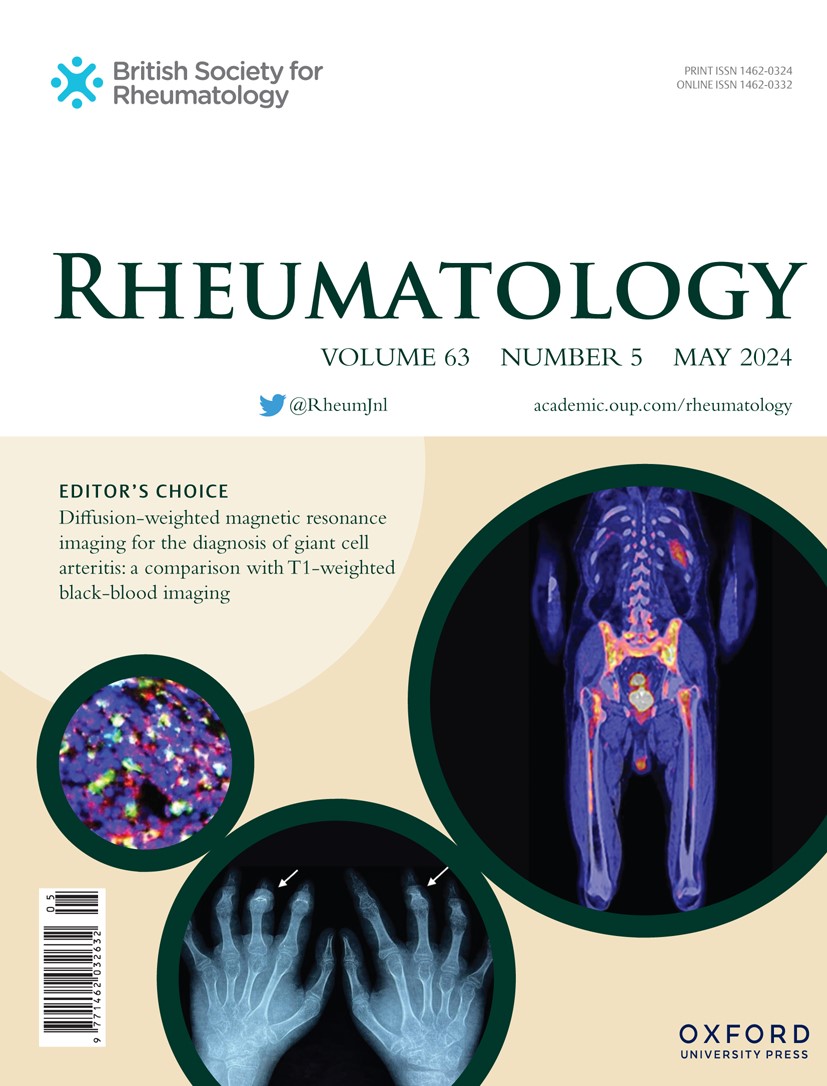P072 Evaluation of two electronic-rehabilitation programmes for persistent knee pain: a randomised feasibility trial
IF 4.7
2区 医学
Q1 RHEUMATOLOGY
引用次数: 0
Abstract
Background/Aims Persistent knee pain is a common cause of disability. Internet-delivered education and exercise may provide an appropriate and scalable treatment option. This trial evaluated the feasibility and acceptability of two electronic-rehabilitation interventions: ‘MyKneeUK’, based on the similar Australian intervention MyKneeExercise, and ‘Group E-Rehab’, developed from a previously tested one-to-one internet-delivered programme. Methods We conducted a non-blinded, randomised feasibility trial with three parallel groups. Eligible participants were aged 45 years or older, with a history of persistent knee pain consistent with clinical diagnosis of knee osteoarthritis. Participants were randomly assigned in a 1:1:1 ratio to either the intervention groups (MyKneeUK, Group E-Rehab) or the control group. The MyKneeUK group received a self-directed unsupervised internet-based home exercise programme plus short message service support (targeting exercise behaviour change) for 12-weeks; the Group E-Rehab group received 7 group-based (5-7 participants/group) physiotherapist-prescribed home exercises delivered via videoconferencing accompanied by internet-interactive educational sessions over 12-weeks; the control arm received usual physiotherapy or continued their usual self-management. Feasibility variables, patient-reported outcomes and clinical findings were measured at baseline, 3 and 9-months. Results Of 149 people screened, 97 were eligible (65.1%) and 90 were randomised (92.8%). Common reasons for ineligibility included knee pain <3-months (n = 13;25%), knee pain during walking ≤4 on 11-point NRS (n = 25;48.1%) and no activity-related joint pain (n = 18;34.6%). Participants had a mean (S.D.) age of 58.2 (7.4) years, 53 were female (58.9%), 70 (77.8%) were using medication for their knee pain and most had pain in multiple joints (mean [S.D] painful joints: 2.9 [2.5]). Of those enrolled, 74 (82.2%) completed 3-month follow-up (Usual Care, 27/30 (90.0%); MyKneeUK, 27/30 (90.0%); Group E-Rehab 20/30 (66.7%)) and 62 (68.9%) completed 9-months (Usual Care, 25/30 [83.3%]; MyKneeUK, 23/30 [76.7%]; Group E-Rehab 14/30 [46.7%]). Compared to usual care, WOMAC pain and function scores were reduced between baseline and 3-months for both MyKneeUK (treatment difference [85%CI], WOMAC pain: -0.57 [-1.71,0.57], WOMAC function, -3.40 [-6.75,-0.06]) and Group E-rehab (WOMAC pain: 0.68 [-2.01,0.65], WOMAC function, -4.38 [-8.07,-0.69]), which was sustained to 9-months. Improvements in favour of both interventions were also seen for other outcomes. There were no serious adverse events and 15 adverse events in 11 participants, reasonably balanced across arms (MyKneeUK 7, Group E-Rehab 4, Usual Care 4). Sample size calculations suggest a definitive trial would be feasible (sample sizes for WOMAC pain primary outcome, 80% power with 20% loss-to-follow-up: MyKneeUK, 144, Group E-rehab, 136). Conclusion Both electronic-rehabilitation interventions met pre-specified feasibility criteria for progression to a full RCT, with the exception of moderately high attrition in the Group E-Rehab arm. This may relate to delays for some participants in commencing the intervention due to group sessions requiring a minimum number randomised to this arm before they could start, which could be addressed with minor protocol changes in a full RCT. Disclosure S.R. Kingsbury: None. D. Groves-Williams: None. G.A. McHugh: None. E.M. Hensor: None. C. Comer: None. M. Conner: None. R.K. Nelligan: None. R.S. Hinman: None. K.L. Bennell: None. P.G. Conaghan: None.评估两种电子康复方案治疗持续性膝关节疼痛:一项随机可行性试验
背景/目的:持续性膝关节疼痛是致残的常见原因。互联网提供的教育和锻炼可以提供适当和可扩展的治疗选择。这项试验评估了两种电子康复干预措施的可行性和可接受性:“MyKneeUK”,基于类似的澳大利亚干预措施“mykneexercise”,以及“Group E-Rehab”,从先前测试过的一对一互联网交付项目发展而来。方法采用非盲法、随机可行性试验,分为三个平行组。符合条件的参与者年龄在45岁或以上,具有与膝关节骨关节炎临床诊断一致的持续性膝关节疼痛史。参与者按1:1:1的比例被随机分配到干预组(MyKneeUK, E-Rehab组)或对照组。MyKneeUK组接受了为期12周的自我指导、无人监督的基于互联网的家庭锻炼计划,外加短信服务支持(目标是改变锻炼行为);e -康复组接受7组(5-7人/组)物理治疗师指定的家庭练习,通过视频会议进行,并辅以互联网互动教育课程,为期12周;对照组接受常规的物理治疗或继续他们通常的自我管理。在基线、3个月和9个月时测量可行性变量、患者报告的结果和临床结果。结果在149人的筛查中,97人符合条件(65.1%),90人随机(92.8%)。不合格的常见原因包括膝关节疼痛3个月(n = 13;25%),行走时膝关节疼痛≤4分(n = 25;48.1%),无活动相关关节疼痛(n = 18;34.6%)。参与者的平均(sd)年龄为58.2(7.4)岁,女性53人(58.9%),70人(77.8%)因膝关节疼痛而使用药物治疗,大多数人有多关节疼痛(平均[S。D .关节疼痛:2.9[2.5])。在入组的患者中,74人(82.2%)完成了3个月的随访(常规护理,27/30 (90.0%);MyKneeUK, 27/30 (90.0%);e组20/30(66.7%)和62(68.9%)完成9个月(常规护理,25/30 [83.3%];MyKneeUK, 23/30 [76.7%];e组14/30[46.7%])。与常规治疗相比,MyKneeUK组的WOMAC疼痛和功能评分在基线和3个月期间均有所降低(治疗差异[85%CI], WOMAC疼痛:-0.57 [-1.71,0.57],WOMAC功能,-3.40 [-6.75,-0.06]),e -康复组(WOMAC疼痛:0.68 [-2.01,0.65],WOMAC功能,-4.38[-8.07,-0.69]),持续到9个月。在其他结果中也可以看到两种干预措施的改善。11名参与者没有发生严重不良事件,15例不良事件,各组之间合理平衡(MyKneeUK 7, E-Rehab组4,常规护理组4)。样本量计算表明,确定的试验是可行的(WOMAC疼痛主要结局的样本量,80%疗效,20%随访损失:MyKneeUK, 144例,E-Rehab组,136例)。结论:两种电子康复干预都符合预先设定的进入完整RCT的可行性标准,除了e-康复组的适度高损耗率。这可能与一些参与者开始干预的延迟有关,因为在开始干预之前,小组会议需要最低数量的随机分组,这可以通过在完整的随机对照试验中对方案进行微小的更改来解决。S.R.金斯伯里:没有。D.格罗夫斯-威廉姆斯:没有。麦克休:没有。E.M.亨索尔:没有。C. Comer:没有。康纳:没有。R.K.内利根:没有。R.S. Hinman:没有。K.L. Bennell:没有。p·g·康纳汉:没有。
本文章由计算机程序翻译,如有差异,请以英文原文为准。
求助全文
约1分钟内获得全文
求助全文
来源期刊

Rheumatology
医学-风湿病学
CiteScore
9.40
自引率
7.30%
发文量
1091
审稿时长
2 months
期刊介绍:
Rheumatology strives to support research and discovery by publishing the highest quality original scientific papers with a focus on basic, clinical and translational research. The journal’s subject areas cover a wide range of paediatric and adult rheumatological conditions from an international perspective. It is an official journal of the British Society for Rheumatology, published by Oxford University Press.
Rheumatology publishes original articles, reviews, editorials, guidelines, concise reports, meta-analyses, original case reports, clinical vignettes, letters and matters arising from published material. The journal takes pride in serving the global rheumatology community, with a focus on high societal impact in the form of podcasts, videos and extended social media presence, and utilizing metrics such as Altmetric. Keep up to date by following the journal on Twitter @RheumJnl.
 求助内容:
求助内容: 应助结果提醒方式:
应助结果提醒方式:


